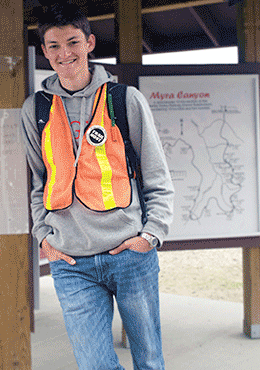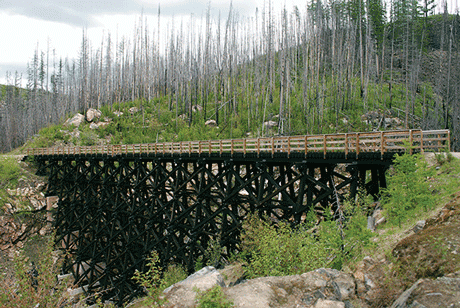
Supply historical and geographical information
My partner and I are asked everything from “can we smoke weed in the tunnel” (um, no) to “where should I propose to my girlfriend” (trestle #7). Railway experts inquire about engine size, rail gauge and weight. Less-than-experts ask an equally entertaining array of questions, including “do the trains still run up here?” (Considering the lack of rails, that would be difficult). Sometimes, answering questions is so much fun that I get carried away. When a Dutch tourist asks if he should bring pepper spray, I reply that it’s a good idea because “the bears prefer spicy meat.” His anxious chuckle suggests that he doesn’t fully appreciate my joke.
If these questions seem odd, then the ones posed by a couple from Munich are surely the oddest. During their hike they take 30 photographs of feces, which they apparently can’t identify. So the amateur Bavarian scatologists begin to question me about the source of each deposit. Disappointment furrows their brows when I tell them the first 10 belong to several species of dog. However, things soon pick up as I identify moose and mule deer scat. When they show me a picture of black bear droppings, they giddily exclaim that they “can’t wait to show all their friends back in Germany.”
“Yeah,” I say, “that’ll be some slideshow.”
Deal with accidents requiring minor first aid
I have experience in patching people up, but when a black lab breaks his leg four kilometres into the canyon I have to improvise. Luckily, the bike rental crew is able to lend me a kids’ trailer to tow behind my bicycle. The plan is to tow the dog to the parking lot, and then sit with him while the owner hikes back. But when the dog keeps jumping out, the plan has to change.
This particular model of chariot is rated for a 30-kilogram 5-year-old. Sitting in mine is a middle-aged man with a black lab on his lap. Collectively, they can’t be shy of 100 kilos. Squeaking and groaning, we set off for the parking lot and, somehow, actually make it.

Traverse the canyon
We make the trek to check for flat tires, fallen branches or fallen people. I’m normally well equipped to tackle all three, but not always. During a lightning storm last year, I turn a corner to find a major landslide. Over 50 trees and several tons of dirt and rock block my path. Looking down at my garden shears, I feel rather outgunned.
During a similar thunderstorm I cross trestle #6, a giant steel bridge. A bolt of lightning cracks. As if a switch has been flipped, the torrential rain immediately follows. I head for my usual haven from stormy weather: the tunnel. The heat of the day’s sun locked up in the rock walls is set free by sheets of rain. The tunnel fills with a warm mist and I can see every exhalation. It’s an otherworldly experience, like breathing under water. Settling in for the duration, I soon hear hurried footsteps coming my way. It seems that someone has a similar idea. To my amazement, a white tail deer lopes into the tunnel and stops within three metres of where I stand pressed against the rock. I hear her panting and see a halo of steam forming around her head. My own cloud of breath is almost close enough to reach it. I’ve never felt more local to the canyon.
Do what?
A trail host interacts with tourists, supplies information, deals with accidents and traverses the canyon. Simple enough. But, he also scares visitors, identifies feces, gives chariot rides to fully-grown men and bonds with deer. It seems that my duties are as changeable as the people, weather and animals that visit the Myra Canyon each year. My job is harsh and beautiful, as if it were driven by the rugged magnificence of the land itself.
In the last 60 seconds of my day, with the tourists retreating to their hotels and campsites, the Okanagan locals begin to filter in. I’m reminded that, while people cross oceans to come here, something about this landscape resonates especially with its inhabitants. I glance over my shoulder at the great gorge. It’s a view that first stirred the heart of Andrew McCulloch 100 years ago, and it does the same for me now. The craggy slopes are as familiar as my own backyard, yet as awe inspiring as the first time I saw them. It’s an intimate captivation that, for a minute, overwhelms me.
I hope that you’ll come visit, experience the wonder, and see what a trail host can do for you.
By Ryan Kluftinger. Photos by Charlotte Thomas.
As seen in August 2013 Okanagan Life.



0 Comments